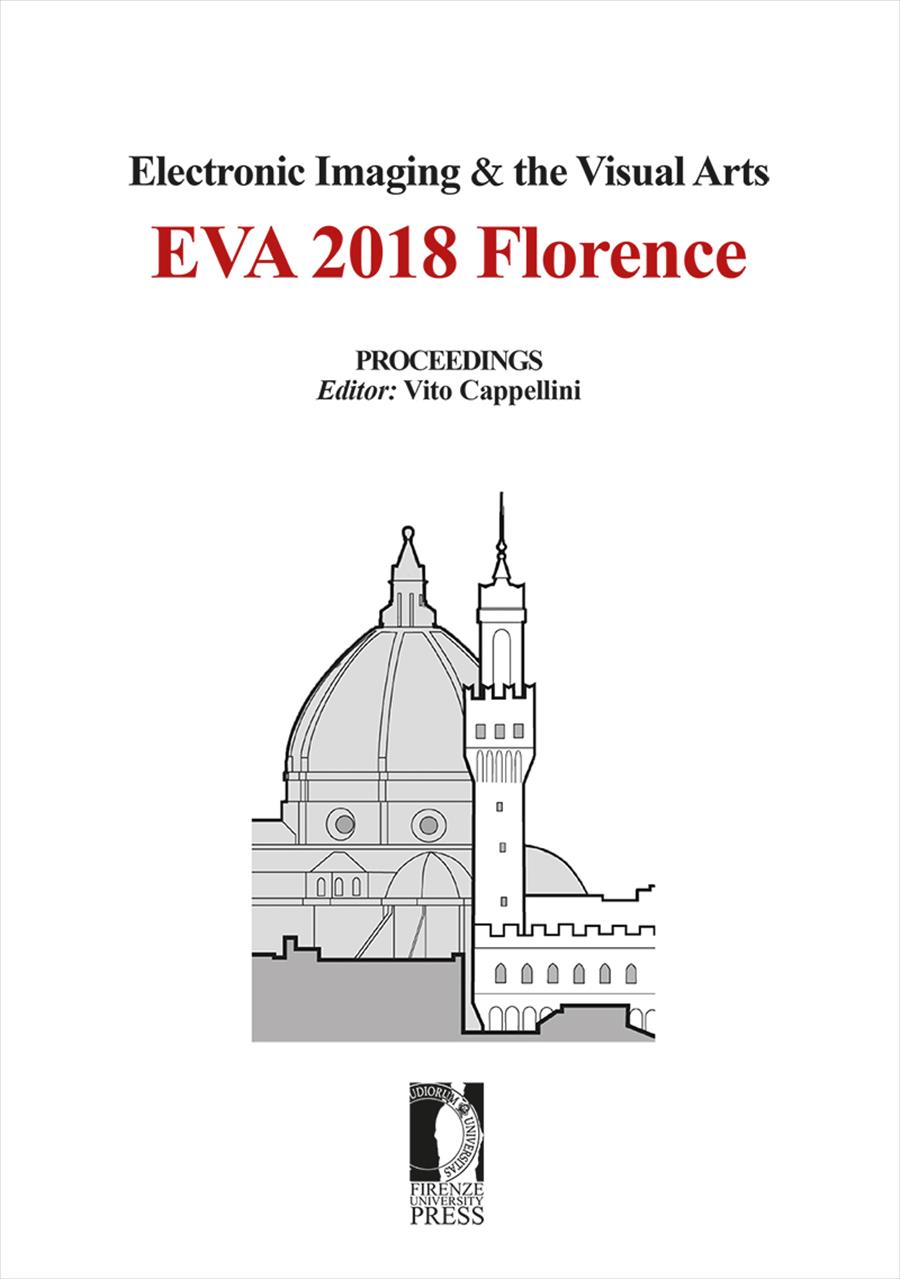- Electronic Imaging & the Visual Arts. EVA 2018 Florence
- Edited by Vito Cappellini
Resisting a Total Loss of Digital Heritage Web 2.0 – Archiving & Bridging Thesaurus for Media Art Histories
- Oliver Grau
- © 2018 Author(s) |
- CC BY 4.0
- DOI: 10.36253/978-88-6453-707-8.29
While Media Art has evolved into a critical field at the intersection of art, science and technology, a significant loss threatens this art form due to the rapid technological obsolescence and static documentation strategies. Addressing these challenges, the Interactive Archive and Meta-Thesaurus for Media Art Research is developed to advance the Archive of Digital Art. www.digitalartarchive.at Through an innovative strategy of ‘collaborative archiving,’ social Web 2.0, 3.0 features foster the engagement of the international Media Art community, and a ‘bridging thesaurus’ linking the extended documentation of the Archive with other databases of ‘traditional’ art history facilitates interdisciplinary and transhistorical comparative analyses.
- Keywords:
- Web 2.0,
- Media Art,
- Interactive Archive,
Danube University Krems, Austria
- The Interactive Archive and Meta-Thesaurus for Media Art Research was conducted by Prof. Oliver Grau (Danube University) and Team: Sebastian Haller, Valerie Kummer, Michaela Seiser, Viola Rühse, Janina Hoth, Wendy Coones, Devon Schiller.
- See <http://digitalartarchive.at>.
- Oliver Grau, “The Database of Virtual Art,” Leonardo 33, No. 4, p. 320 (2000).
- Oliver Grau, Virtual Art: From Illusion to Immersion (Cambridge, MA: MIT Press, 2003) Christiane Paul, Digital Art (New York: Thames and Hudson, 2003).
- Aby Warburg, “Heidnisch-antike Weissagung in Wort und Bild zu Luthers Zeiten,” Zeitschrift für Kirchengeschichte 40 (1922) pp. 261–262.
- Gottfried Boehm, Was ist ein Bild?, pp. 11–38. (Munich,1994). James Elkins, The Domain of Images (Ithaca, NY: Cornell UP, 1999). W.J.T. Mitchell, Picture Theory: Essays on Verbal and Visual Representation (Chicago: University of Chicago Press, 1995). Klaus Sachs-Hombach (Ed.), Bildwissenschaft (Frankfurt am Main, 2005).
- Andreas Broeckmann/Gunalan Nadarajan (Eds.), Place Studies in Art, Media, Science and Technology: Historical Investigations on the Sites and the Migration of Knowledge (Weimar:VDG, 2009). Oliver Grau, Imagery in the 21st Century Cambridge, MIT Press: 2011). Oliver Grau (Ed.), MediaArtHistories (Cambridge, MIT Press, 2007). Erkki Huhtamo, “Elements of Screenology. Toward an Archaeology of the Screen, in: Iconics, The Japan Society of Image Arts and Sciences, Vol. 7, pp. 31–82 (2004). Martin Kemp, Christ to Coke: How Image Becomes Icon (Oxford, 2011).
- Steve Dixon, Digital Performance: A History of New Media in Theatre, Dance, Performance Art, and Installation (Cambridge: MIT Press, 2007). Edward Shanken, Art and Electronic Media (London: Phaidon, 2009). C. Sommerer/L. Mignonneau, “Modeling Complexity for Interactive Art Works on the Internet,” pp. 85–107 in John Casti/Anders Karlqvist (Eds.), Art and Complexity: At the Interface (Amsterdam, 2003). Stephen Wilson, Art and Science Now: How scientific research and technological innovation are becoming key to 21st—century aesthetics (London: Thames and Hudson, 2010).
- Renate Buschmann/Caianiello Tiziana, (Eds.), Media Art Installations Preservation and Presentation: Materializing the Ephemeral (Berlin: Dietrich Reimer Verlag, 2013). Jon Ippolito/Richard Rinehart, Re-collection: Art, New Media, and Social Memory (Cambridge, MA: MIT Press, 2014). Christiane Paul, “Context and Archive: Presenting and Preserving Net-Based Art,” Available from: http://143.50.30.21/static/publication09/np_paul 09.pdf (2009). Sandra Fauconnier, “Capturing Unstable Media: Summary of Research,” Available from <http://v2.nl/files/2003/publishing/articles/capturing_summary.pdf> (2003).
- Grau 2003.
- See <mediaarthistories.org>.
- For example, the Langlois Foundation in Montreal (2000–2008), Netzspannung at the Fraunhofer Institut (2001–2005), MedienKunstNetz at ZKM (2004–2006), The Boltzmann Institute for Media Art Research in Linz (2005–2009). The Variable Media Network, <http://www.variablemedia.net/>. And the Capturing Unstable Media project by V2, <http://v2.nl/archive/works/capturing-unstable-media>.
- MEDIA ART NEEDS GLOBAL NETWORKED ORGANISATION & SUPPORT – International Declaration, <http://www.mediaarthistory.org/declaration>.
- Oliver Grau, “For an Expanded Concept of Documentation: The Database of Virtual Art,” ICHIM, École du Louvre, Paris 2003, Proceedings, pp. 2–15 (2003).
- The PostGreSQL Database is open Source and the operation system is Linux based.
- In accordance with the guidelines of the ‚Categories for the Description of Works of Art’ (CDWA), the AT.MAR vocabulary considers ‘subject’ as “the narrative, iconic, or nonobjective meaning conveyed by an abstract or a figurative composition. It is what is depicted in and by a work of art.
- See <www.gssg.at>.
Chapter Information
Chapter Title
Resisting a Total Loss of Digital Heritage Web 2.0 – Archiving & Bridging Thesaurus for Media Art Histories
Authors
Oliver Grau
Language
English
DOI
10.36253/978-88-6453-707-8.29
Peer Reviewed
Publication Year
2018
Copyright Information
© 2018 Author(s)
Content License
Metadata License
Bibliographic Information
Book Title
Electronic Imaging & the Visual Arts. EVA 2018 Florence
Book Subtitle
Florence (9-10 May 2018)
Editors
Vito Cappellini
Peer Reviewed
Number of Pages
200
Publication Year
2018
Copyright Information
© 2018 Author(s)
Content License
Metadata License
Publisher Name
Firenze University Press
DOI
10.36253/978-88-6453-707-8
ISBN Print
978-88-6453-706-1
eISBN (pdf)
978-88-6453-707-8
eISBN (xml)
978-88-9273-104-2
Series Title
Proceedings e report
Series ISSN
2704-601X
Series E-ISSN
2704-5846
